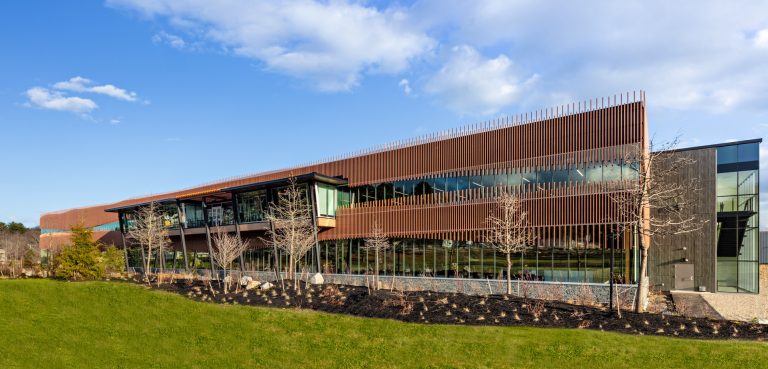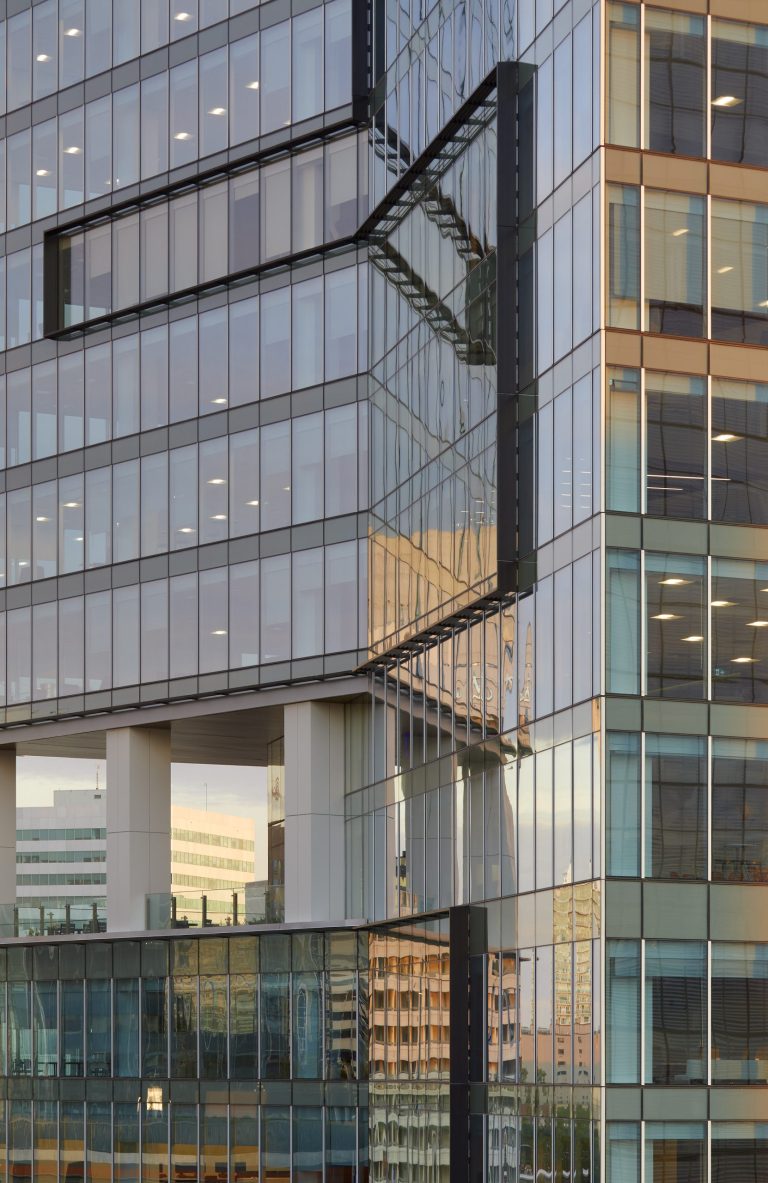As a proud member of the U.S. Green Building Council (USGBC), Kawneer is excited to announce the arrival of LEED v5. The latest version (V5) of the Leadership in Energy and Environmental Design (LEED) standard emphasizes decarbonization, enhancing the well-being of building occupants, and protecting ecosystems. In this article, we cover the key focus areas of LEED v5, new features and requirements, along with how Kawneer is aligning with these sustainability goals.
Updated Rating Systems for Diverse Project Types
LEED v5 introduces refined rating systems tailored to specific project categories to ensure more precise and impactful sustainability strategies, including:
- BD+C (Building Design and Construction)
- New Construction
- Core and Shell
- ID+C (Interior Design and Construction)
- Commercial Interiors
- O+M (Operations and Maintenance)
- Existing Buildings
These updates ensure that each project type receives a targeted approach to sustainability, from initial design to long-term operations.
Key Enhancements in LEED v5
LEED v5 brings several changes that align with the urgent need for climate action and performance accountability, including:
- Carbon and Energy Focus: New prerequisites and credits emphasize carbon reduction, energy efficiency and renewable energy integration, reinforcing LEED’s role in driving decarbonization.
- Lifecycle Performance Alignment: The system now better aligns performance expectations across the entire building lifecycle, from design to operations, encouraging long-term sustainability.
- Stricter Platinum Certification: Achieving LEED Platinum is now more rigorous, with heightened requirements around energy and carbon performance, ensuring low carbon, sustainable projects truly lead the way.
- Flexible Credit Prioritization: Project teams have greater flexibility to prioritize credits based on local context and project-specific goals, making LEED more adaptable and agile.
- Predictable Update Cycle: LEED v5 introduces a five-year development cycle with the next major update expected in 2030, providing clarity and consistency for long-term planning.
Key Focus Areas of LEED v5:
LEED v5 places a strong emphasis on reducing carbon emissions throughout a building’s lifecycle, including strategies to minimize both operational and embodied carbon impacts.
The new version also incorporates a heightened focus on social equity and human health, recognizing the critical connection between the built environment and occupant well-being. LEED v5 aims to improve health, well-being, resilience and equity for building occupants and their communities.
Further, LEED v5 emphasizes strategies that limit environmental degradation and contribute to the restoration of ecosystems, ensuring that the built environment exists harmoniously with nature.
The Role of Multi-Attribute Certifications
Multi-attribute certifications are more important than ever as these certifications offer a comprehensive, third-party verified assessment of a product’s environmental and health impacts across its lifecycle. Unlike single-attribute labels, they evaluate multiple criteria such as:
- Energy and water use
- Emissions and material toxicity
- Recyclability and circularity
New Features and Requirements:
- Streamlined Credit Categories: LEED v5 reorganizes and streamlines credit categories to improve clarity and usability. The rating system now aligns credits and prerequisites around three global goals: climate action, quality of life and conservation and ecological restoration.
- Mandatory Building Enclosure Commissioning: Aligning with updated standards such as ASHRAE 90.1-2019, LEED v5 requires building enclosure commissioning to ensure energy efficiency and performance.
- Continuous Indoor Air Quality Monitoring: The updated system awards more points for real-time, continuous monitoring of indoor air quality parameters, promoting healthier indoor environments.
How is Kawneer Supporting LEED v5?
Kawneer is actively supporting the criteria of LEED v5 and advancing sustainable building practices through delivering a wide range of high-performance architectural solutions containing sustainable materials and providing product transparency documentation for Kawneer’s products.
One of Kawneer’s primary initiatives to promote sustainability is the adoption of a low-carbon aluminum billet standard, which requires a minimum of 50% recycled content and sources remaining prime aluminum from clean energy smelters. This approach significantly reduces embodied carbon and aligns with LEED v5’s emphasis on climate action and material health. To learn more about this initiative, explore Kawneer’s whitepaper that discusses the impact of selecting aluminum products for building projects and the environmental benefits that come with aluminum.
In addition to material innovation, Kawneer provides company- and product-specific Environmental Product Declarations (EPDs), offering verified data on the environmental impact of its products across their life cycles. This level of transparency supports LEED credits related to product disclosure and optimization. Kawneer also promotes material transparency through Declare labels, which disclose product ingredients and support healthier building environments. Further, a wide range of Kawneer’s products have earned multi-attribute Cradle to Cradle (C2C) certifications, reflecting Kawneer’s leadership in circular design, material health and responsible manufacturing. Learn more about Kawneer’s commitment to product transparency. In addition, Kawneer has pledged to drive supply chain due diligence with commitment to have 50% of its material purchase from supplies that have gone through supply chain assessment via EcoVadis.
These efforts demonstrate Kawneer’s commitment to sustainability and its proactive role in helping architects and builders meet the evolving requirements of LEED v5.
Conclusion
LEED v5 is designed to provide greater flexibility for projects and more opportunities to evolve rating system requirements in response to a rapidly changing market. The latest version aims to drive the market towards a near-zero carbon reality that is equitable and resilient while promoting wise and safe use of all resources.
Kawneer’s sustainable architectural aluminum systems are designed to help building projects achieve their LEED v5 certification goals. Kawneer’s products support the transition to low-carbon, sustainable buildings by contributing to energy efficiency and promoting environmental stewardship.
With a commitment to innovation and sustainability, Kawneer continues to advance modern architectural design through manufacturing resilient, high-performing architectural aluminum products that shape distinctive, sustainable buildings and promote occupant comfort and well-being.
Learn more about LEED v5.
Discover Kawneer’s commitment to holistic sustainability through Kawneer’s BALANCE approach.
















